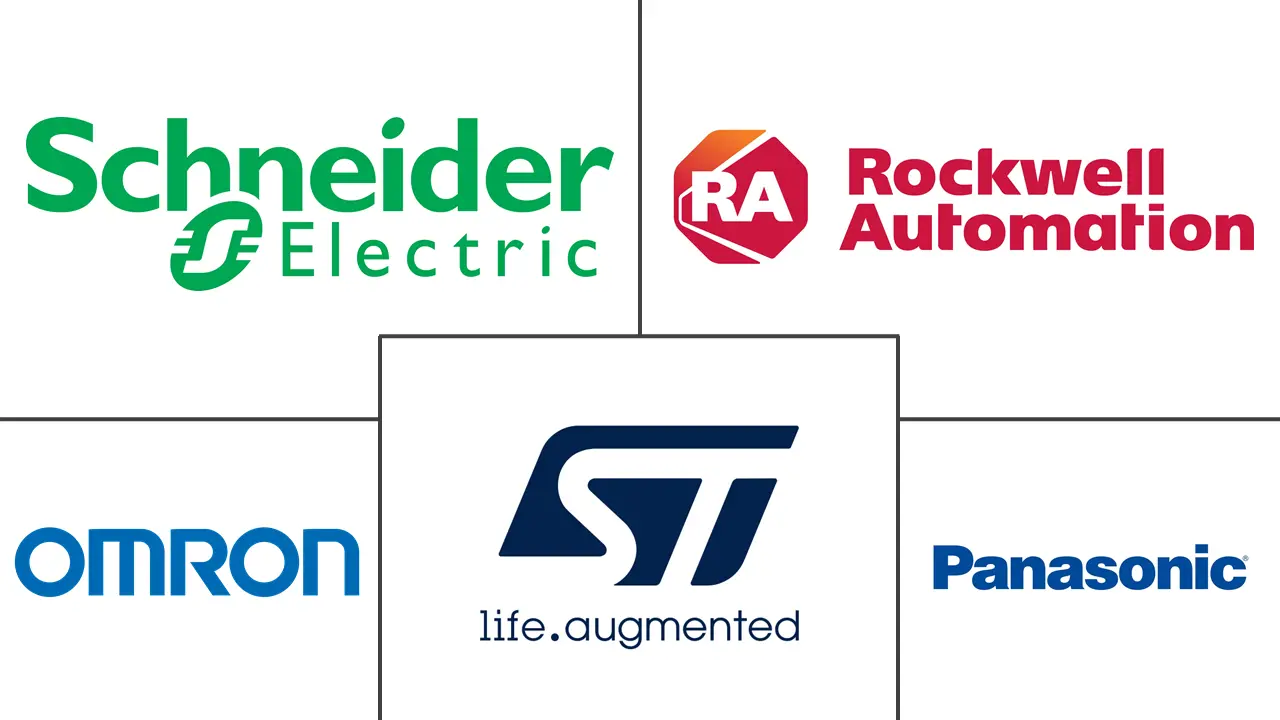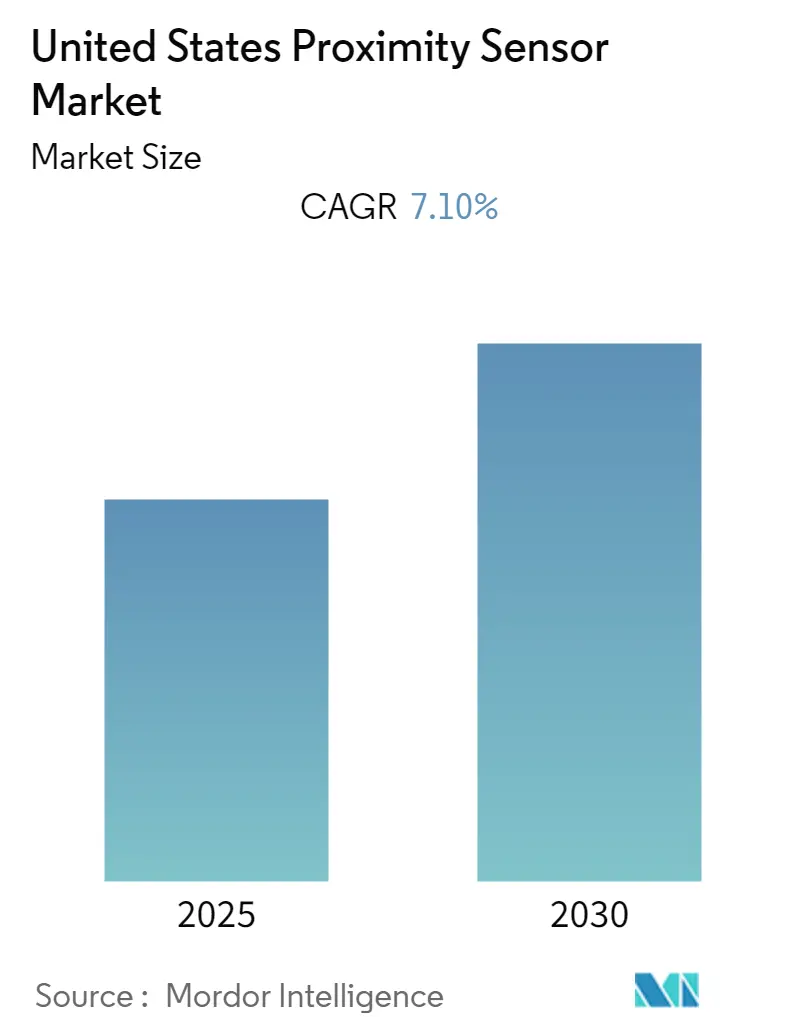
United States Proximity Sensor Market Analysis by Mordor Intelligence
The United States Proximity Sensor Market is expected to register a CAGR of 7.1% during the forecast period.
- In the United States, modern facilities are becoming more complex and diverse with urbanization and population growth. For instance, according to a world development indicators survey conducted by the World Bank, it was found that the degree of urbanization in the United States was 82.66% in 2020.
- The sensor information data would aid in managing various urban facilities and the effective response to emergencies and accidents through information sharing. Intelligent urban vehicles would require multiple sensors to monitor a variety of phenomena. These various types of proximity sensors constantly monitor the position and control of the vehicle, increasing their demand in urban infrastructures and propelling the proximity sensor market forward.
- Moreover, in the era of technological advancement, new innovative proximity sensors - Time of Flight (ToF) sensors - can protect health in various ways while maintaining social distance. For instance, STMicroelectronics introduced high-performance proximity and ranging sensors based on FlightSense Time of Flight technology in July 2020. These Time of Flight (ToF) sensors aid in developing 3D sensing capabilities for a wide range of products used by customers daily.
- Further, with the growing impact of COVID-19 on various industries, businesses are following social distance through advanced technologies. As a result of the pandemic, the demand for proximity sensors has increased as they improve workplace safety and ensure contact tracing through proximity detection tags to ensure business continuity.
- However, designing miniaturized sensors without affecting their quality poses a challenge for the proximity sensor market growth.
United States Proximity Sensor Market Trends and Insights
The Automotive Segment is Expected to Drive the Market's Growth
- Proximity sensors are widely used in automotive applications to detect objects close to vehicles. These sensors alert the driver and provide information about the vehicle's status. Engine temperature, battery charging check, speed control, fuel level, and other prominent applications of proximity sensors in automobiles include the following. In some cases, these sensors are installed on doors and handle to detect objects in the event of a collision or warning.
- Further, autonomous technologies, such as parking assist systems and ADAS, use a variety of sensors, such as temperature sensors, motion detectors, photon sensors, and so on. These sensors are critical to autonomous systems because they generate the data required for efficient and accurate operation.
- The market for advanced driver-assistance systems (ADAS) that automatically monitor, warn, and control braking and vehicle steering is expected to increase as a result of regulatory and consumer interest in safety applications that protect passengers and reduce accident fatalities.
- For instance, the United States has mandated that vehicles be equipped with autonomous emergency braking (AEB) and forward-collision warning (FCW) systems by 2020. This is propelling the market for automotive proximity sensors.
- Connected and autonomous vehicles are significant developments in the automotive industry. An increase in the per capita income of the consumers as a result of economic developments is elevating their standard of living. The rise, which is also fueling demand for autonomous vehicles, can be attributed to the increase in demand for luxury and comfort vehicles. Vehicles with AEB, ADAS, FCW, and PAS systems are driving the automotive proximity sensor market.
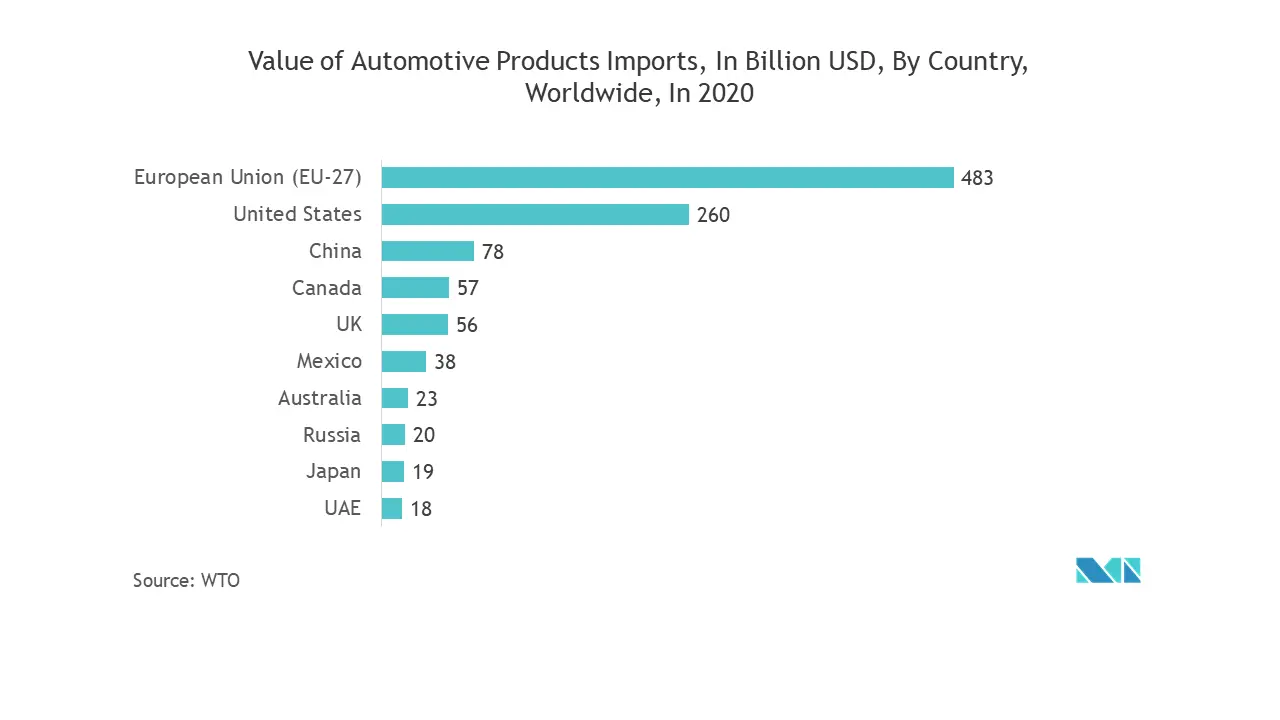
Inductive Proximity Sensor is Expected to Hold a Major Market Share
- The inductive proximity sensors are cost-effective and reliable solutions for most applications in automation equipment and machinery. They are not influenced by vibrations, water, oil, and dust, making them suitable for harsh environments. Some of the prominent applications of these sensors include machine tools, agriculture, and material handling systems.
- Inductive sensors play a crucial role in securing quality and higher productivity from the automated process. As these sensors have no moving parts, their service life is independent of the number of operation cycles.
- The demand for inductive proximity sensors is being driven by increased material handling in industrial and automotive applications. Proximity sensors are typically attached to material handling equipment (MHE) such as forklifts; when an entity (a person or other MHE) is detected, they activate a signal.
- The growing industrial advancement is compelling industries like manufacturing, oil, and gas to utilize inductive proximity sensors for automation. For instance, in the oil and gas industry, inductive proximity sensors provide a durable and dependable solution for measuring variables on offshore oil rigs. These sensors can withstand harsh sea conditions, such as saltwater, which could be corrosive and damaging to equipment. Consequently, deploying inductive proximity sensors can safely measure the ultimate positions of pipe handlers and other moveable components on the rig without performance being influenced by the elements.
- However, these sensors can only detect metal objects, limiting their functionality in other industries that do not use metal, which can affect the growth of the US proximity sensor market.
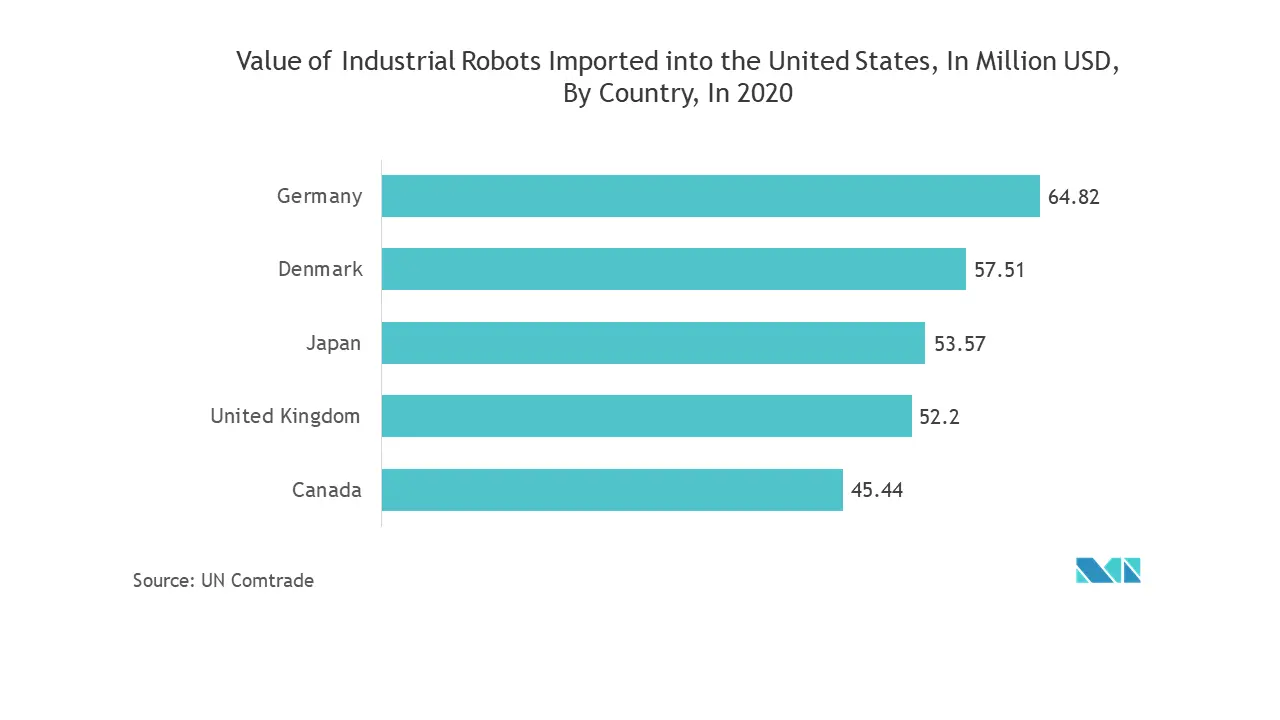
Competitive Landscape
The United States Proximity Sensor Market is a fragmented market with intense competition. Some prominent players include STMicroelectronics, OMRON Corporation, Honeywell International Inc., Panasonic Corporation, etc. These companies are leveraging strategic collaborative initiatives to increase their market share and profitability. The competition and rapid technological advancements are expected to threaten the growth of the companies in the said market during the forecast period.
- September 2020 - Riko Optoelectronics Technology Co. Ltd expanded its product range by introducing JM - N3/P3 Rectangular Inductive Proximity Sensor. The sensors have a sensing distance of 2mm+_ 10%.
- May 2020 - STMicroelectronics expanded the capabilities of its FlightSense ToF ranging sensors with the introduction of the VL53L3CX, which features patented histogram algorithms that allow measuring distances to multiple objects while increasing accuracy. Unlike conventional infrared sensors, the VL53L3CX measures objects ranging from 2.5cm to 3m and is unaffected by target color or reflectance. This enables designers to incorporate powerful new features into their products, such as allowing occupancy detectors to provide error-free sensing by ignoring unwanted background or foreground objects or reporting exact distances to multiple targets within the sensor's field of view.
United States Proximity Sensor Industry Leaders
STMicroelectronics
OMRON Corporation
Rockwell Automation, Inc.
Schneider Electric
Panasonic Corporation
- *Disclaimer: Major Players sorted in no particular order
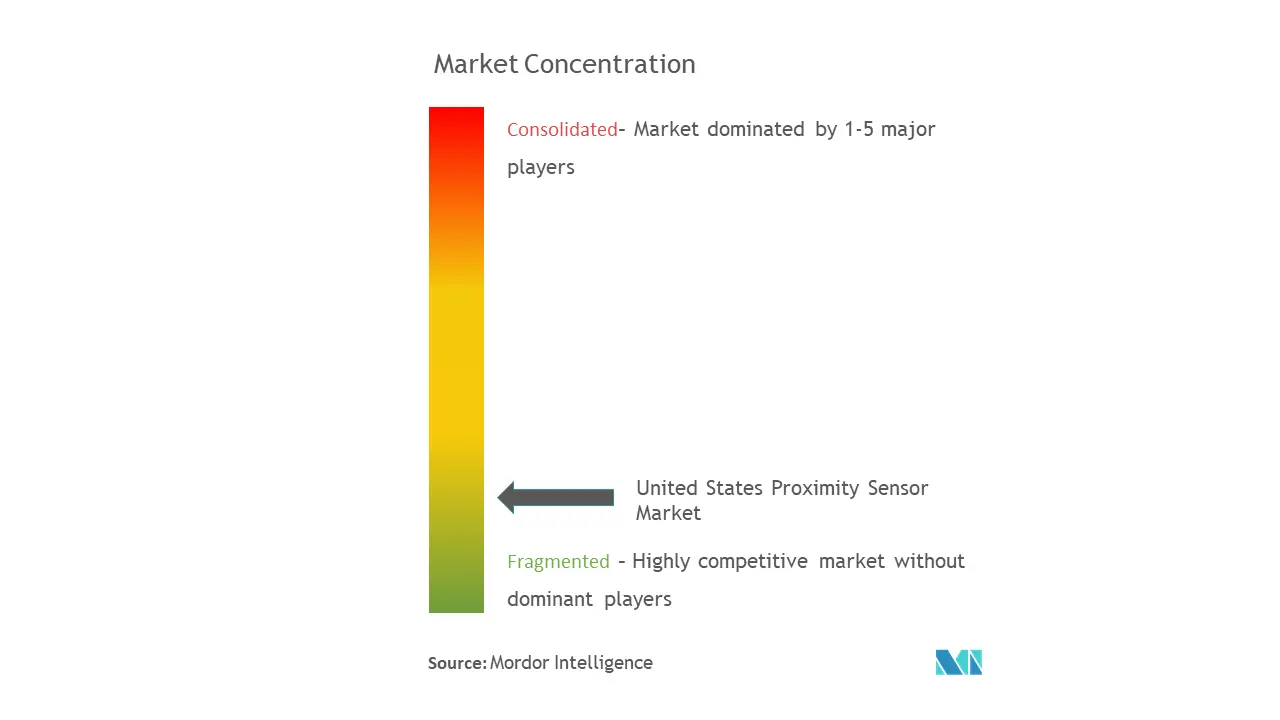
United States Proximity Sensor Market Report Scope
A proximity sensor is a sensor that detects the presence of nearby objects without the need for physical contact. A proximity sensor frequently emits an electromagnetic field or a beam of electromagnetic radiation (for example, infrared) and detects changes in the field or return signal.
The United States Proximity Sensor Market is Segmented by Technology (Inductive, Capacitive, Photoelectric, Magnetic, Ultrasonic), Channel Type (Single Channel and Multi-Channel), End-User (Aerospace and Defense, Automotive, Automation, Industrial, Consumer Electronics, Food & Beverage, Pharmaceutical, Construction, Energy).
| Inductive |
| Capacitive |
| Photoelectric |
| Magnetic |
| Ultrasonic |
| Other Technology |
| Single Channel |
| Multi-Channel |
| Aerospace and Defense |
| Automotive |
| Industrial Automation |
| Consumer Electronics |
| Food & Beverage |
| Pharmaceutical |
| Construction |
| Energy |
| Other End-users |
| Technology | Inductive |
| Capacitive | |
| Photoelectric | |
| Magnetic | |
| Ultrasonic | |
| Other Technology | |
| Channel Type | Single Channel |
| Multi-Channel | |
| End-User | Aerospace and Defense |
| Automotive | |
| Industrial Automation | |
| Consumer Electronics | |
| Food & Beverage | |
| Pharmaceutical | |
| Construction | |
| Energy | |
| Other End-users |
Key Questions Answered in the Report
What is the current United States Proximity Sensor Market size?
The United States Proximity Sensor Market is projected to register a CAGR of 7.1% during the forecast period (2025-2030)
Who are the key players in United States Proximity Sensor Market?
STMicroelectronics, OMRON Corporation, Rockwell Automation, Inc., Schneider Electric and Panasonic Corporation are the major companies operating in the United States Proximity Sensor Market.
What years does this United States Proximity Sensor Market cover?
The report covers the United States Proximity Sensor Market historical market size for years: 2019, 2020, 2021, 2022, 2023 and 2024. The report also forecasts the United States Proximity Sensor Market size for years: 2025, 2026, 2027, 2028, 2029 and 2030.
Page last updated on:
United States Proximity Sensor Market Report
Statistics for the 2025 United States Proximity Sensor market share, size and revenue growth rate, created by Mordor Intelligence™ Industry Reports. United States Proximity Sensor analysis includes a market forecast outlook for 2025 to 2030 and historical overview. Get a sample of this industry analysis as a free report PDF download.
